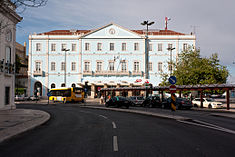Santa Apolónia railway station
| Santa Apolónia Station (Estação Ferroviária de Santa Apolónia) | |
| Soldiers Wharf Station | |
| Train station (Estação Ferroviária) | |
|
A view of the Santa Apolónia railway station, along Rua Terceira Lopes
|
|
| Official name: Estação do Cais dos Soldados/Estação Ferroviária de Santa Apolónia | |
| Named for: Santa Apolonia | |
| Country | |
|---|---|
| Region | Lisbon |
| Subregion | Greater Lisbon |
| District | Lisbon |
| Municipality | Lisbon |
| Location | São Vicente |
| - coordinates | 38°42′49″N 9°7′23.4″W / 38.71361°N 9.123167°WCoordinates: 38°42′49″N 9°7′23.4″W / 38.71361°N 9.123167°W |
| Architects | Oppermann, Angel Arribas Ugarte, João Evangelista Abreu, Lecrenier |
| Materials | Masonry, Limestone, Glass, Wrought Iron, Wood |
| Owner | Portuguese Republic |
| For public | Public |
| Easiest access | Largo dos Caminhos de Ferro; Avenida Infante Dom Henrique; Rua dos Caminhos de Ferro |
| Management | Instituto Gestão do Patrimonio Arquitectónico e Arqueológico |
| Operator | Comboios de Portugal |
| Status | Unclassified |
|
Location of the station within the municipality of Lisbon
|
|
|
Santa Apolónia
|
|||||||||||
|---|---|---|---|---|---|---|---|---|---|---|---|
| Intermodal station | |||||||||||

Intercidades (intercity) transport on the platform
|
|||||||||||
| Location | Santo Apolónia Avenida Infante Dom Henrique 73 Lisboa 1100 São Vicente Portugal |
||||||||||
| Operated by | Comboios de Portugal | ||||||||||
| Line(s) | Sintra line Norte line Azambuja line |
||||||||||
| Platforms | 8 | ||||||||||
| Train operators | Comboios de Portugal, Lisbon Metro | ||||||||||
| Connections | Lisbon Metro, Bus, Taxi | ||||||||||
| Construction | |||||||||||
| Disabled access | Station without architectural barriers, Ramp/lift for train access, Disabled toilets | ||||||||||
| Other information | |||||||||||
| Website | https://www.cp.pt/passageiros/en/train-times/Stations/Lisboa-Oriente | ||||||||||
| Services | |||||||||||
|
|||||||||||
The Santa Apolónia Station is oldest railway terminus in Portugal. Situated in the civil parish, in the central part of the municipality of Lisbon, on the northern margin of the Tagus River in the historical district of Alfama.
In December 1844, under the initiative of José Bernardo da Costa Cabral, the Companhia das Obras Públicas was founded, with the purpose of constructing a rail line between Lisbon and Spain, in addition to intermodal station between rail and maritime services. The station was known as the Cais da América or Cais da Europa, and allowed rail passengers from Europe to offload to ships for America.
The initial project was for the construction at the Cais dos Soldados (Soldiers Wharf). Meanwhile, in December 1852, the engineer Thomaz Rumball proposed two alternatives, alongside the Museu Militar de Lisboa (Military Museum of Lisbon), or in the proximity of the Largo do Intendente. Another engineer, Harcourt White, also rejected the option of Cais dos Soldades on January 1853, affirming that there did not exist, in that local, sufficient space to construct a station. He suggested that the station be implanted along the river, after the Church of Anjos in Xabregas, where at the time there was free space. An executive committee was nominated to plan the construction of the Lisbon station, proposing the construction of a building along Rocha do Conde de Óbidos, with the capacity to receive passengers and commerce, with one of the lines continuing to area around the customs house in Terreiro do Paço. The construction project to Spain, therefore, began this year, under orders of Fontes Pereira de Melo,
The actual project to construct the station at Cais dos Soldados was approved by the government on 8 March 1854. The plan presented a station that included distinctive elements for commercial and passenger traffic, repair workshops, warehouses and services. For the passenger terminal, the government acquired the old Convent of Santa Apolónia, but the former army arsenal in the location was demolished to make way for the final design. From the beginning, the rail line and the commercial wharf required that land be reclaimed along the Tagus River.
...
Wikipedia


